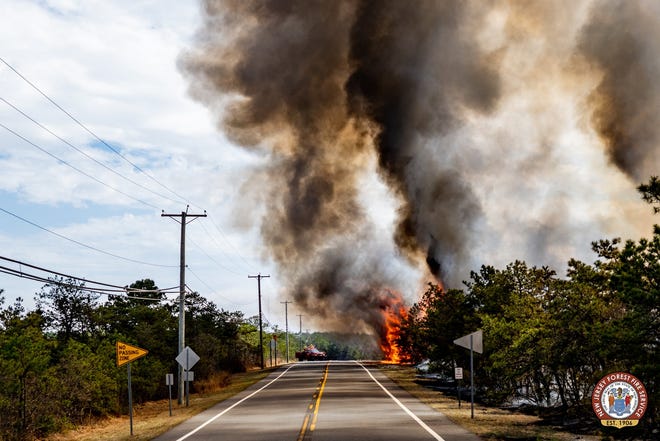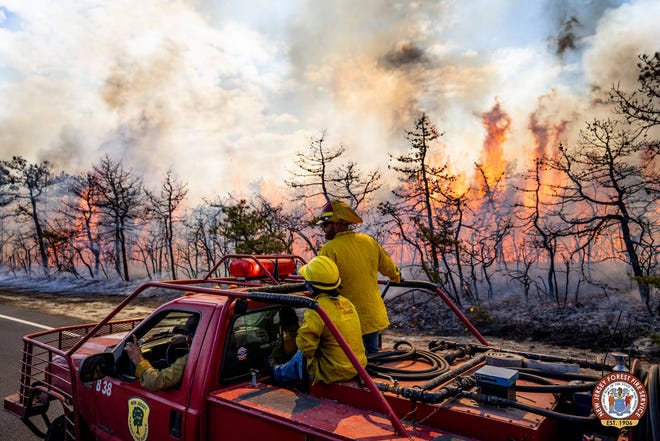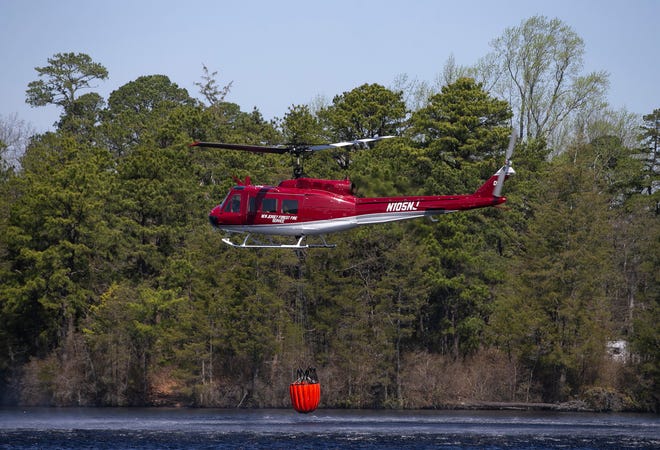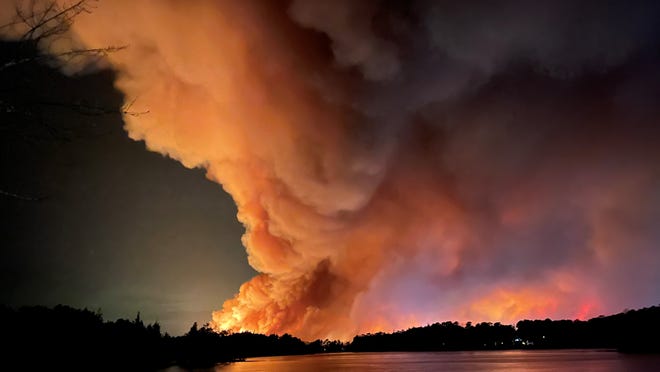[ad_1]
Across New Jersey, the cinders of three large wildfires continue to smolder under ash and debris.
In the past week, fires burned 3,859 acres across Manchester, 972 acres in West Milford, and 1,607 acres Little Egg Harbor.
April is the peak of New Jersey’s forest fire season, and already firefighters have fought more this year than they have in each of the two prior seasons.
“This is essentially our Super Bowl,” said Bill Love, an assistant division fire warden at the New Jersey Forest Fire Service. “April is when we have these large fires throughout the state and small fires in addition. A lot of these fires you don’t even ever hear about.”
This year is even more active for fire than usual, according to the Forest Fire Service.
So far, the Forest Fire Service recorded 517 wildfires that consumed more than 7,600 acres of New Jersey forest as of Tuesday morning. For comparison, just 327 wildfires burned 471 acres by mid-April 2022, according to John Cecil, the Department of Environmental Protection’s assistant commissioner for state parks. The year before that, 373 wildfires burned more than 500 acres, he said.
Anatomy of a wildfire:‘This definitely had high potential to be extremely catastrophic’
Shortly after he shared those statistics Tuesday, another large wildfire erupted in Washington Township, Burlington County. As of Tuesday night, the fire spread across 257 acres and threatened 30 structures near Route 542, according to the Forest Fire Service.
“We had a drought last year, and we’ve had dry conditions at the beginning of this year,” said Cecil. “We didn’t have very much snowfall. The snowfall we did have was in limited portions of the state. All of that (is) contributing to the conditions and fire activity that we’re seeing out there over the last several weeks, if not (past) month.”

The spring’s particularly dry weather, in addition to the fact that deciduous trees have not yet fully “leafed out” to shade the forest floor, makes brush and potential kindling hot and parched in the sun, according Greg McLaughlin, Chief of the New Jersey Forest Fire Service.
These dry forest fuels, in conjunction with gusty spring winds and low humidity, can quickly feed a forest fire when exposed to a spark or burning ember, according to state firefighters.
“As fire’s spreading, you have this preheating effect that’s happening in front of the fire,” McLaughlin said. “That preheating effect creates a more intense fire and a fire that spreads more quickly.”
The process lays the groundwork for burning embers to ignite spot fires ahead of the primary blaze.
To make matters worse, state fire officials say a new pattern is emerging that is driving the increase in fire risk.

“Our warm seasons are being extended by about a month on average,” said Cecil. “We’re seeing spring arrive earlier, and summer and warm temperatures linger longer.”
In northern New Jersey, the emerald ash borer, an invasive beetle that kills ash trees, contributed to fire risk in the West Milford blaze by leaving snags throughout the area, according to state firefighters.
“There’s large patches of dead trees, and this wood deteriorates very quickly and becomes almost similar to Styrofoam,” said McLaughlin. “It burns like paper and so it (fire) spreads. And it’s difficult to cut these trees down because they have no structural integrity. They fall apart very easily.”

Within the Pinelands, where successful fire suppression efforts have protected trees for years, the forest is now dense, Cecil said. Once ignited, this thick forest proves difficult to extinguish.
“We have moved a project through the Pinelands Commission’s approval process to undertake forest thinning and firebreak creation in the Allen and Oswego Road area, that is to the southwest of where the Log Swamp fire occurred (in Little Egg Harbor),” Cecil said.
He added: “This (thinning) work that we’re proposing to do… is incredibly important. We have got to get these Pinelands forests back to a more natural condition. That means thinning them. That does mean cutting some small trees to let the healthier trees grow bigger and stronger to withstand these fires and create more natural conditions, so that we can have low and slow fires moves to the forest.”
Pinelands forests rely on fire to kill competitor trees, such as oaks, as well as open pinecones to spread seeds. The thick bark of pitch pines helps these trees survive forest fires.
All of the challenges facing New Jersey forests — dense forest in the Pinelands, dead trees from invasive insects in norther New Jersey, a longer warm season and climate variability — are increasing the risks of wildfire, Cecil said.
“Ninety-nine percent of fires are caused by humans in this state,” said Love. “Only 0.1% are caused by lightning… As long as the public assists us, we’ll be able to keep these fires at a small size.”
Homeowners can play an important role in minimizing fire risk on their property. Some steps residents can take include:
- Replace wood mulch with stone.
- Keep gutters clear of debris and vegetation.
- Replace missing or damaged roof shingles.
- Install metal screens over vents and windows to keep burning embers out of homes.
- Keep vegetation, leaf piles and wood piles at least 5 feet away from homes.
- Do not store items under decks and patios, and screen or box in areas underneath to prevent leaves from accumulating.
‘Dear Lord, protect your house’:How Manchester church survived close brush with wildfire
[ad_2]
Source_link



